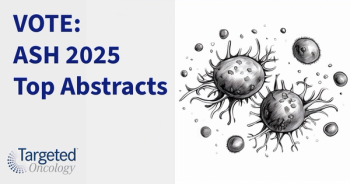
Study Shows First-Time Survival Benefit for Soft Tissue Sarcoma
Marking the first time a phase III study has shown a survival advantage for patients with soft tissue sarcoma, treatment with eribulin (Halaven) demonstrated improved overall survival (OS) by 2 months compared with dacarbazine in patients with advanced leiomyosarcoma (LMS) and adipocytic sarcoma (ADI).
Marking the first time a phase III study has shown a survival advantage for patients with soft tissue sarcoma, treatment with eribulin (Halaven) demonstrated improved overall survival (OS) by 2 months compared with dacarbazine in patients with advanced leiomyosarcoma (LMS) and adipocytic sarcoma (ADI).
This is the very first phase III trial investigating patients with soft tissue sarcoma to demonstrate an overall survival benefit of a new agent compared with an active agent,” said lead study author Patrick Schöffski, MD, MPH, head of Department of General Medical Oncology, University Hospitals Leuven in Leuven, Belgium, during a press briefing at the 2015 ASCO Annual Meeting. This is a clinically meaningful result given the high unmet medical need in this rare, hard-to-treat family of diseases.
Topline findings from the study were announced in late February 2015. At this time, Eisai, the company developing the drug, announced plans to submit the data to the US Food and Drug Administration (FDA) for regulatory approval.
In the open-label study, 452 patients with advanced soft tissue sarcoma were randomized to receive eribulin (n = 228) or dacarbazine (n = 224).1Eribulin was administered at 1.4 mg/m2on days 1 and 8, and dacarbazine was administered at 850 mg/m2, 1000 mg/m2, or 1200 mg/m2on day 1 of each 21-day cycle.
Patients enrolled had high- or intermediate-grade sarcoma, and the majority had received two or more prior therapies. The primary endpoint of the study was OS, with secondary outcomes focused on progression-free survival (PFS) and safety.
The median OS was 13.5 months with eribulin compared with 11.5 months with dacarbazine (HR = 0.768; 95% CI, 0.618-0.954;P= .0169). Median PFS was 2.6 months in both arms of the study (HR = 0.877; 95% CI, 0.710-1.085;P= .229). The 12-week PFS rate was 33% with eribulin and 29% with dacarbazine; however, this difference was not deemed statistically significant.
All-grade adverse events (AEs) were seen in almost all patients in the study. The most common AEs in the eribulin arm were neutropenia (43.8%), fatigue (43.8%), nausea (40.3%), alopecia (35%), and constipation (31.4%). With dacarbazine, the most common AEs were nausea (47.3%), fatigue (38.4%), anemia (30.8%), thrombocytopenia (27.7%), and constipation (25.9%).
We looked at the safety profile of the drugs that we used in this trial and we found that the safety findings matched our experience with these two drugs in other settings of oncology, Schöffski said. There were no new safety findings. There were only two treatment-related deaths in this study, both occurring in the eribulin arm.”
Grade 3 treatment-related AEs were reported in 67.3% of patients treated with eribulin compared with 56.3% with dacarbazine. The most common grade ≥3 AEs with eribulin were neutropenia (35.4%) and anemia (7.1%) versus neutropenia (15.6%), anemia (12.1%), and thrombocytopenia (15.2%).
This was a small step for cancer but a giant step for sarcoma. There has never been a positive study for survival in sarcoma, ever. This is the first positive sarcoma study showing a survival benefit for any therapy,” said ASCO expert Gary K. Schwartz, MD, chief of Columbia University Medical Centers Division of Hematology & Oncology, during the briefing. There are side effects. I think they are manageable, but they have to be balanced against the advantages in certain patients.
Eribulin is a synthetic analog of halichondrin B, a polyether macrolide derived from the marine sponge Halichondria okadai. The FDA initially approved eribulin in 2010 for the treatment of patients with metastatic breast cancer. This approval was based on a 2.5-month extension in OS experienced by patients treated with eribulin compared with physician’s choice of treatment in the phase III EMBRACE trial.
Findings from the phase III sarcoma study are consistent with earlier results seen in a phase II analysis published inLancet Oncology.2 In this study, patients with LMS (n = 38) who received eribulin had a median PFS of 3 months and a 12-week PFS rate of 31.6%. The median PFS for patients with ADI (n = 32) was also 3 months, and the PFS rate was 46.9%.
References
1. Schöffski P, Maki RG, Italiano A, et al. Randomized, open-label, multicenter, phase III study of eribulin versus dacarbazine in patients (pts) with leiomyosarcoma (LMS) and adipocytic sarcoma (ADI).J Clin Oncol. 2015;(suppl; abstr LBA10502).
<<<
2.Schöffski P, Ray-Coquard IL, Cioffi A, et al. Activity of eribulin mesylate in patients with soft-tissue sarcoma: a phase 2 study in four independent histological subtypes.Lancet Oncol. 2011;12(11):1045-1052.









































